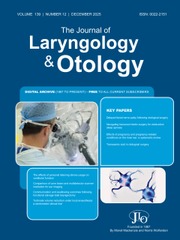Crossref Citations
This article has been cited by the following publications. This list is generated based on data provided by
Crossref.
Hussain, Musheer
Fisher, Edward
Youngs, Robin
and
Fishman, Jonathan
2017.
Voice in T1b glottic tumours, intratympanic steroids for salvage in sensorineural hearing loss, intranasal steroids for obstructive sleep apnoea and a new procedure for post-radiation nasal stenosis.
The Journal of Laryngology & Otology,
Vol. 131,
Issue. 5,
p.
377.
Camacho, Macario
Noller, Michael W.
Zaghi, Soroush
Reckley, Lauren K.
Fernandez-Salvador, Camilo
Ho, Erika
Dunn, Brandyn
and
Chan, Dylan
2017.
Tongue surgeries for pediatric obstructive sleep apnea: a systematic review and meta-analysis.
European Archives of Oto-Rhino-Laryngology,
Vol. 274,
Issue. 8,
p.
2981.
Insalaco, Louis F.
and
Scott, Andrew R.
2018.
Peripartum Management of Neonatal Pierre Robin Sequence.
Clinics in Perinatology,
Vol. 45,
Issue. 4,
p.
717.
Luo, Dongyuan
Chen, Yiyang
Wang, Hongtao
Li, Ting
Fan, Li
Wenli, Wu
Jiayu, Liu
and
Jiansuo, Hao
2018.
The Effect of Mandibular Distraction Osteogenesis on Weight Velocity in Infants With Severe Pierre Robin Syndrome.
Journal of Craniofacial Surgery,
Vol. 29,
Issue. 7,
p.
1851.
Stark, Thomas R.
Pozo-Alonso, Manuel
Daniels, Raj
and
Camacho, Macario
2018.
Pediatric Considerations for Dental Sleep Medicine.
Sleep Medicine Clinics,
Vol. 13,
Issue. 4,
p.
531.
Ishman, Stacey L.
Chang, Katherine W.
and
Kennedy, Aimee A.
2018.
Techniques for evaluation and management of tongue-base obstruction in pediatric obstructive sleep apnea.
Current Opinion in Otolaryngology & Head & Neck Surgery,
Vol. 26,
Issue. 6,
p.
409.
Randall, Robyn S.
Kian, Aaron
Chin, Katherine
and
French, Brooke
2018.
Resolution of obstructive sleep apnea after mandibular distraction osteogenesis in setting of delayed tongue–lip adhesion takedown.
Medicine,
Vol. 97,
Issue. 42,
p.
e12853.
Hopkins, Brandon
Dean, Kelly
Appachi, Swathi
and
Drake, Amelia F.
2019.
Craniofacial Interventions in Children.
Otolaryngologic Clinics of North America,
Vol. 52,
Issue. 5,
p.
903.
Hsieh, Sun T.
and
Woo, Albert S.
2019.
Pierre Robin Sequence.
Clinics in Plastic Surgery,
Vol. 46,
Issue. 2,
p.
249.
Mills, Nikki
Keough, Natalie
Geddes, Donna T.
Pransky, Seth M.
and
Mirjalili, S. Ali
2019.
Defining the anatomy of the neonatal lingual frenulum.
Clinical Anatomy,
Vol. 32,
Issue. 6,
p.
824.
Fontanari, Marco
Vellone, Valentino
Maffia, Francesco
Papoff, Paola
and
Cascone, Piero
2020.
Floating Bone Phenomenon in Pierre Robin Sequence.
Journal of Craniofacial Surgery,
Vol. 31,
Issue. 6,
p.
1699.
Komelyagin, Dmitry Yu.
Dubin, Sergey A.
Philipp I. Vladimirov, Philipp I.
Petukhov, Alexey V.
Yamatina, Svetlana V.
Staroverova, Elena N.
Blagikh, Oleg E.
Gromova, Tatyana N.
Striga, Elena V.
and
Strogonov, Igor A.
2021.
Treatment of children with Pierre Robin Syndrome.
City Healthcare,
Vol. 2,
Issue. 3,
p.
35.
Li, Carol
Kou, Yann-Fuu
and
Ishman, Stacey L.
2021.
Pediatric OSA: Evidence-Based Review of Treatment Results.
Current Otorhinolaryngology Reports,
Vol. 9,
Issue. 3,
p.
246.
Duarte, Daniele W.
Schweiger, Claudia
Manica, Denise
Fagondes, Simone
Fleith, Iran J.
Rojas, Juan J. C.
Zanin, Eduardo M.
Portinho, Ciro P.
and
Collares, Marcus V. M.
2021.
Predictors of Respiratory Dysfunction at Diagnosis of Robin Sequence.
The Laryngoscope,
Vol. 131,
Issue. 12,
p.
2811.
Markiewicz, Michael R.
Miloro, Michael
and
Yates, David
2022.
Peterson’s Principles of Oral and Maxillofacial Surgery.
p.
2089.
Pourtaheri, Navid
Maniskas, Seija
Chandler, Ludmila
and
Steinbacher, Derek M.
2022.
Mandibular Distraction Osteogenesis in Robin Sequence Using Three-Dimensional Analysis and Planning.
Plastic & Reconstructive Surgery,
Vol. 149,
Issue. 5,
p.
962e.
Ishman, Stacey
2023.
Obstructive Sleep Apnea.
p.
121.
Zaballa, Katrina
Singh, Jagdev
and
Waters, Karen
2023.
The management of upper airway obstruction in Pierre Robin Sequence.
Paediatric Respiratory Reviews,
Vol. 45,
Issue. ,
p.
11.
Fulton, G. Kyle
Blessing, Matthew S.
and
Evans, Kelly N.
2024.
Avery's Diseases of the Newborn.
p.
1269.
Magge, Hari N.
Schild, Sam D.
Mantilla-Rivas, Esperanza
Landry, Evie C.
Afsar, Nina M.
Behzadpour, Hengameh K.
Manrique, Monica
Rana, Md Sohel
Oh, Albert K.
and
Reilly, Brian K.
2024.
Trends in Natural Decannulation in Patients with Robin Sequence: A Twenty-five Year Retrospective Review.
Annals of Otology, Rhinology & Laryngology,
Vol. 133,
Issue. 1,
p.
69.




